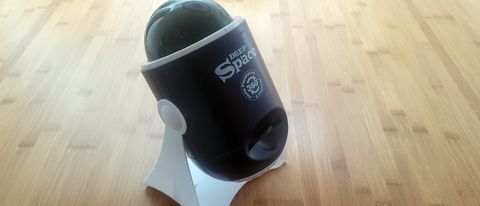Space Verdict
A value-for-money STEM toy with multiple functions. Kids between 6 and 10 will love to learn more about space with this hands-on device.
Pros
- +
Good value star projector
- +
Easy to transport
- +
Kid-friendly
Cons
- -
Noisy motor
- -
Requires 3 x AA batteries (included)
Why you can trust Space.com
Brainstorm Toys pride itself on creating educational and interactive STEM toys that help children learn more about their environment. As avid lovers of all things space here at space.com, we like nothing more than seeing engaging toys and activities for children that inspire curiosity and exploration of the night sky.
Size: 130mm x 250mm x 320mm
Bulb Type: 2 x LED
Rotation: Yes (planetarium end)
Sleep timer: No
Speaker: No
Projection Surface: slides 1m, stars not specified
Having reviewed an array of the best star projectors, the product that piqued our interest is the Brainstorm Deep Space Home Planetarium and Projector.
Created for children age six and up, it features a slide projector and a rotating star projector that also doubles up as a simple dome-shaped blue night light. We bought one for ourselves to give an honest hands-on review.
Brainstorm Toys Deep Space Home Planetarium and Star Projector: Design
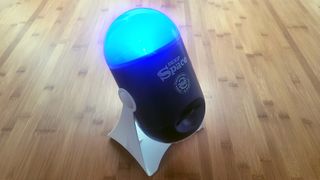
- Fun, kid-friendly packaging
- Resembles a famous sci-fi character
- Pivots vertically on its stand to expose different functionality
The first thing to mention is the packaging, it is colorful and attractive to children and would be lovely to unwrap as a gift. It comes in the kind of packaging that makes you want to open the box and investigate inside right away. Obviously aimed at children, it shows the projector, constellations on a purple backdrop and a photo of two children looking up at the projector in awe. Everything is translated into five different languages, as they are in the instruction manual as well.
Whether it is intentional or not, the appearance of the Deep Space Home Planetarium and Projector bears a resemblance to the much-loved Star Wars character R2-D2. Constructed from blue and white plastic and sitting on a triangular base, the device is free to pivot vertically almost 360 degrees. It has two different ends: the planetarium, which rotates and displays stars and constellations depending on which of the supplied domes you use. At the other end is a slide projector with a large focusing ring.
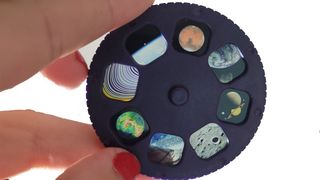
It comes with three separate easy-to-hold disks, each featuring eight color images of spacecraft, astronauts, nebulae and planets taken by NASA and the Hubble Telescope. The 'planetarium end' can also be covered with a further supplied translucent blue dome to turn it into a nightlight.
It is well constructed, but of course, as it is designed for children, it feels toyish compared to the sleek 'grown up' design of the Sega Homestar Flux. We haven't tested it, but we can imagine if it were to be dropped onto a hard surface, it would probably get damaged as with most devices containing electronic components with plastic construction. This is why it is reasonable to recommend it for children aged six and up.
Brainstorm Toys Deep Space Home Planetarium and Star Projector: Performance
- Nice analog feel when using it
- The rotating motor is quite noisy
- The projection is clear and bright
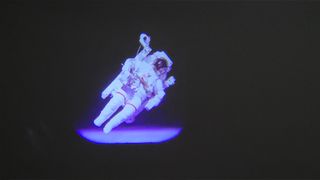
The first thing we tried was the slide projector functionality. It's pretty self-explanatory to get started. Insert one of the disks into the slot in the front of the device, and slide the power button to the right (labeled disc projector). You then manually rotate the disk with your finger to the desired image and use the large kid-friendly focusing ring, shown below, to make the picture nice and sharp on the projection surface.
It all feels very analog; it wouldn't feel the same if you had the option of electronically switching and focusing the slides — we like the hands-on approach. When it's dark, the resulting image is nice and clear, and it's possible for the projection to be as big as 3.2ft (1m) wide.
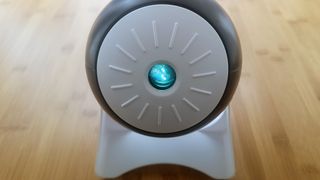
The planetarium end is a bulb on a rotating surface, on which you put one of the three domes. One is an array of stars, one shows the shapes of the constellations in the Northern Hemisphere, and the other is an opaque blue dome to transform the unit into a nice blue hue night light.
We would like the ability to turn the motor off as it is quite noisy. We found the noise distracting when writing this review and turned it off. Unlike devices like the National Geographic Astro Planetarium or the Encalife Aurora Borealis projector, there is no in-built speaker to play sounds or music alongside the projection to dampen the noise from the motor.
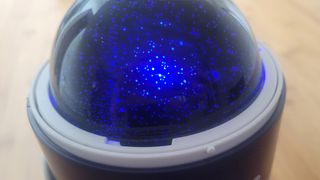
Brainstorm Toys Deep Space Home Planetarium and Star Projector: Functionality
- 3-in-1 functionality, with limitations
- Powered by 3 x AA batteries (included)
- Portable as there are no cables
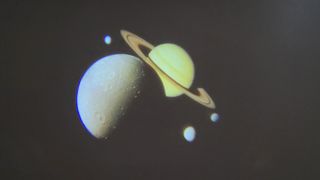
Unless you have a child who likes a whirring sound to drift off to sleep (we know some do), the motor will likely keep them awake. The device is also powered by 3 x AA batteries (included) which we imagine would run down quickly if being used on a nightly basis.
That said, the projector functionality works very well, and with 24 different images and a 'secret code' that links to online learning material about each image on the slide, this can be a fun product for homeschooling or simply taking time with your child to learn more about space.
If you load up the Fun & Games section on the Brainstorm Ltd website first, it breaks the discs down into their categories (Nebulae, Spacecraft & Astronauts and Planets & the Moon) and walks you through interesting information about what can be seen on each slide.

We would describe the star projections as being satisfactory. They are frustratingly fuzzy though, giving the impression they need to be focused, which isn't possible. However, they fill the room with little blue dots and rotate slowly to create a nice space-inspired ambiance. The same is true with the constellations. They can be seen more clearly when you use the constellation dome with the blue translucent dome over the top, though this removes the 'projection' element.
Should I buy the Brainstorm Toys Deep Space Home Planetarium and Star Projector?
The three-in-one functionality of this model and a reasonable price tag make it good value for money.
While it's not a mind-blowing star projector, it is great as an educational STEM toy and we haven't reviewed a device yet that acts as both a star projector and planetarium.
We are fans of the hands-on approach, but we also appreciate that it can be enjoyed with the digital educational accompaniment. It would have perhaps been preferable to have this accompaniment in printed form rather than having to go online to negate the need for screen time. That said, we appreciate the 'secret' code because we think the 'exclusive access' is exciting for younger users.
To summarize, if you don't want to spend too much and are looking for an educational but fun product for children age 6+, we don't think you can go too far wrong.
If the Brainstorm Toys Deep Space Home Planetarium and Star Projector isn't for you
For less of a scientific learning tool and a more impressive light display, with a quieter motor, the BlissLights Sky Lite 2.0 is worth your attention. It is not scientific at all, but it is a fun way to see lights and patterns that are loosely comparable to deep-space imagery. It is also often reduced to the same price as the Brainstorm Planetarium and Projector reviewed here, so there usually isn't much between the two financially.
If all you're looking for is a back-to-basics, simple laser pointer to fill your child's room with stars, again BlissLights have the tiny BlissLights StarPort USB projector which would fit the bill, although only for children who are the appropriate age and won't look directly into the laser beam.
If only the real night sky is good enough for your child, take a look at our best telescopes for kids and best binoculars for kids buying guides so you can help them get the most from their stargazing experience.
Join our Space Forums to keep talking space on the latest missions, night sky and more! And if you have a news tip, correction or comment, let us know at: community@space.com.

Tantse Walter is a photographer and adventurer that's spent seven years facilitating global adventurous expeditions. She loves getting into the nitty-gritty of sourcing and planning trips. Whether that be for astrophotography location scouting, or just for the love of exploration. Tantse enjoys taking creative, bright and bold photos of people, places, animals and the night sky. Tantse’s photos have been purchased by notable companies such as Ford and Cross Country Trains as well as an upcoming book about the songs, rituals and musical history of Capoeira.
